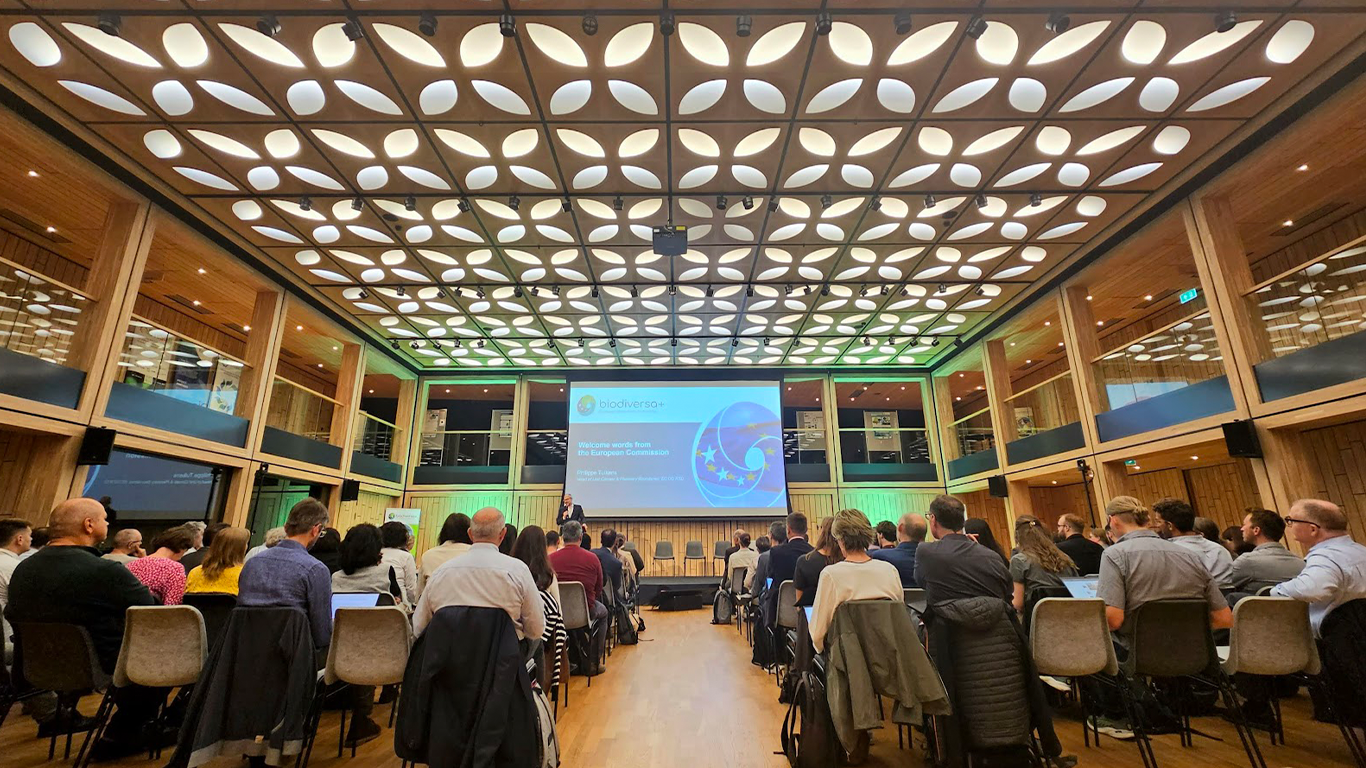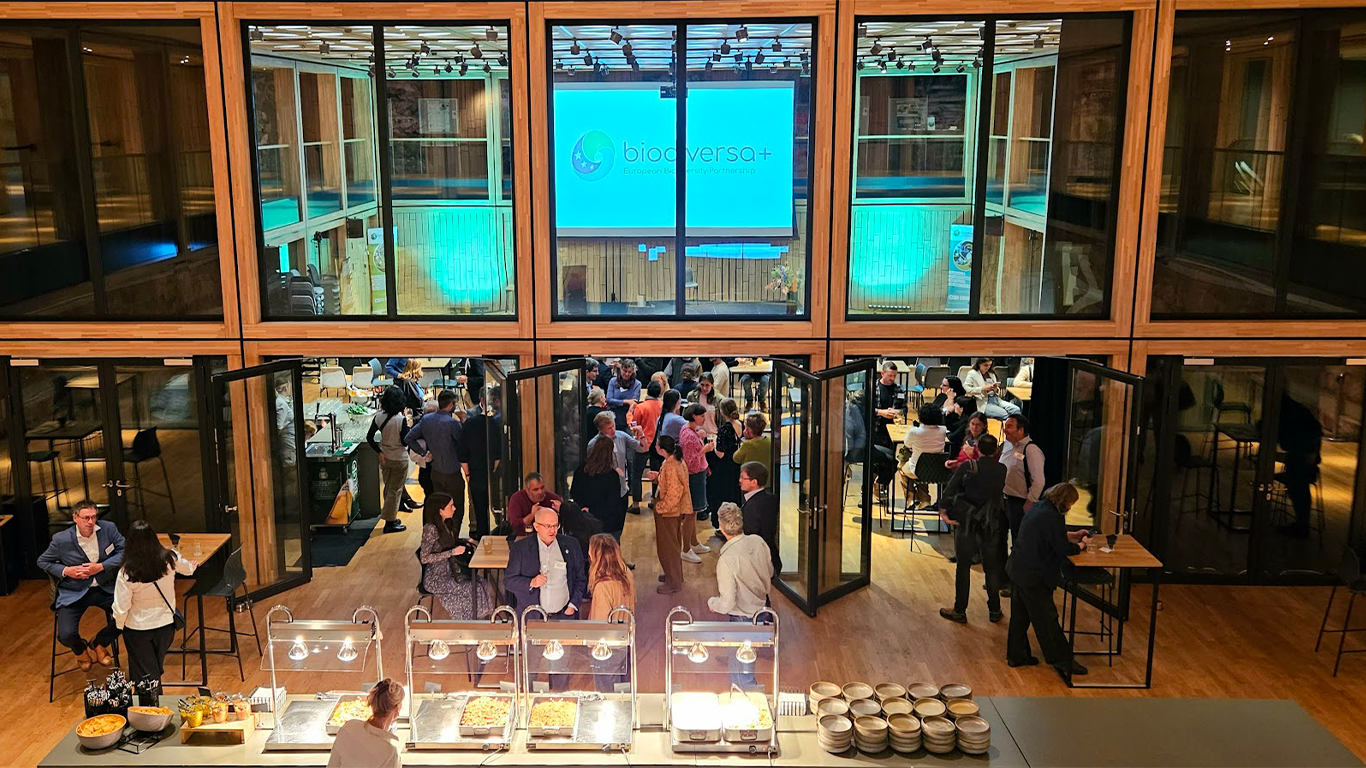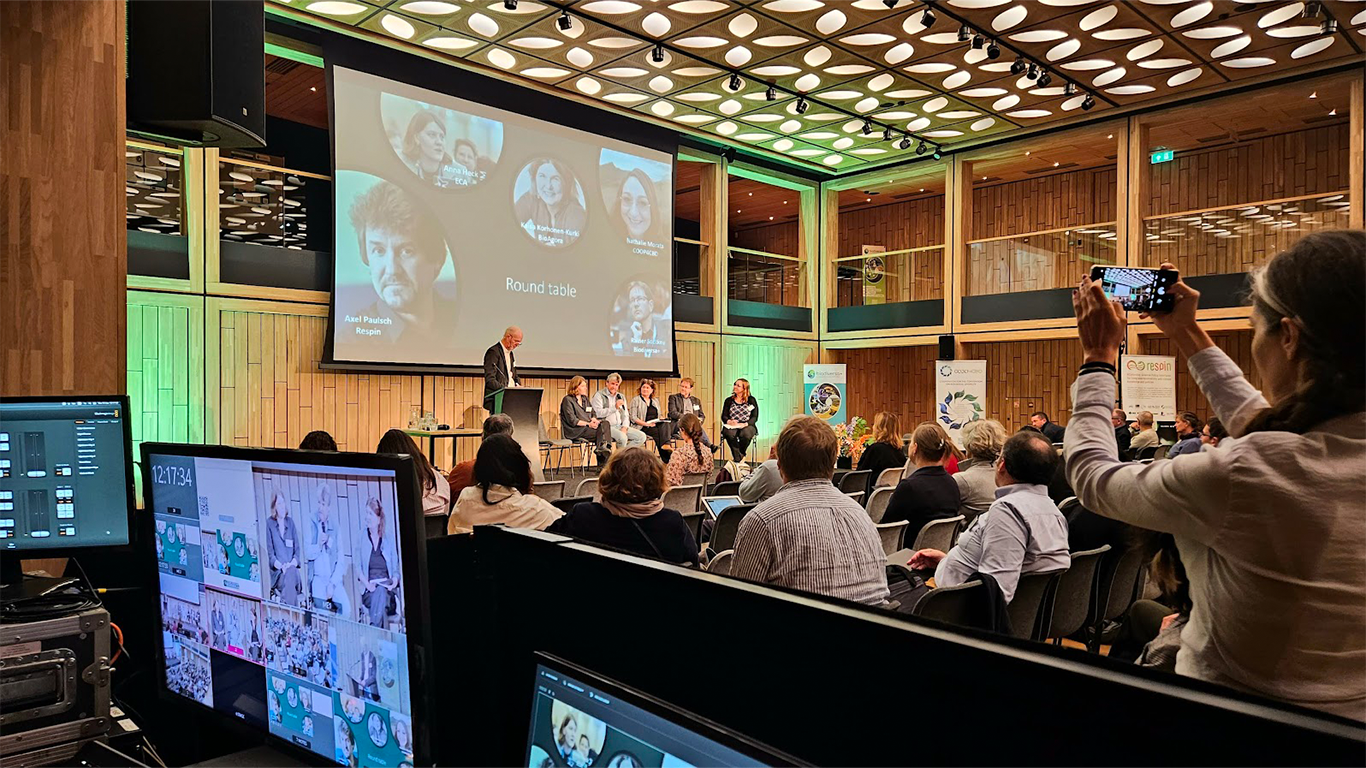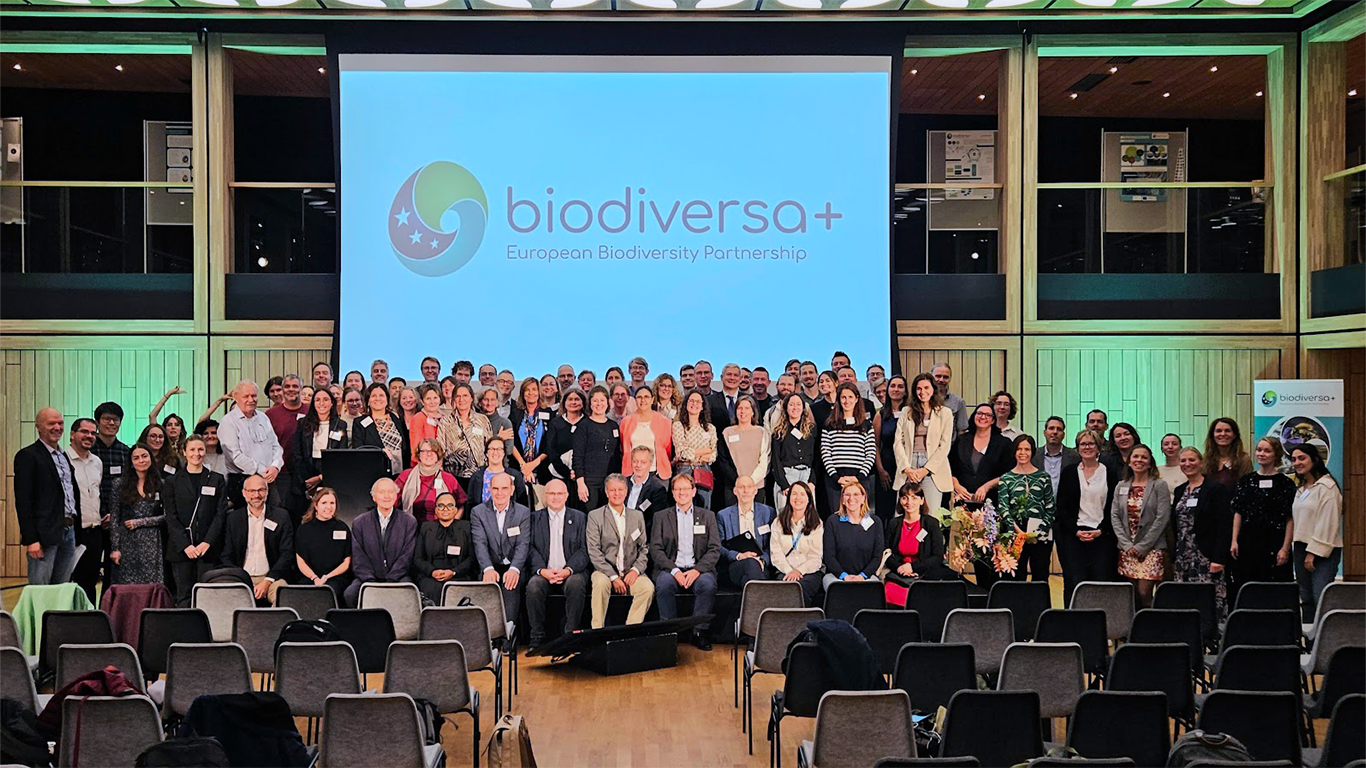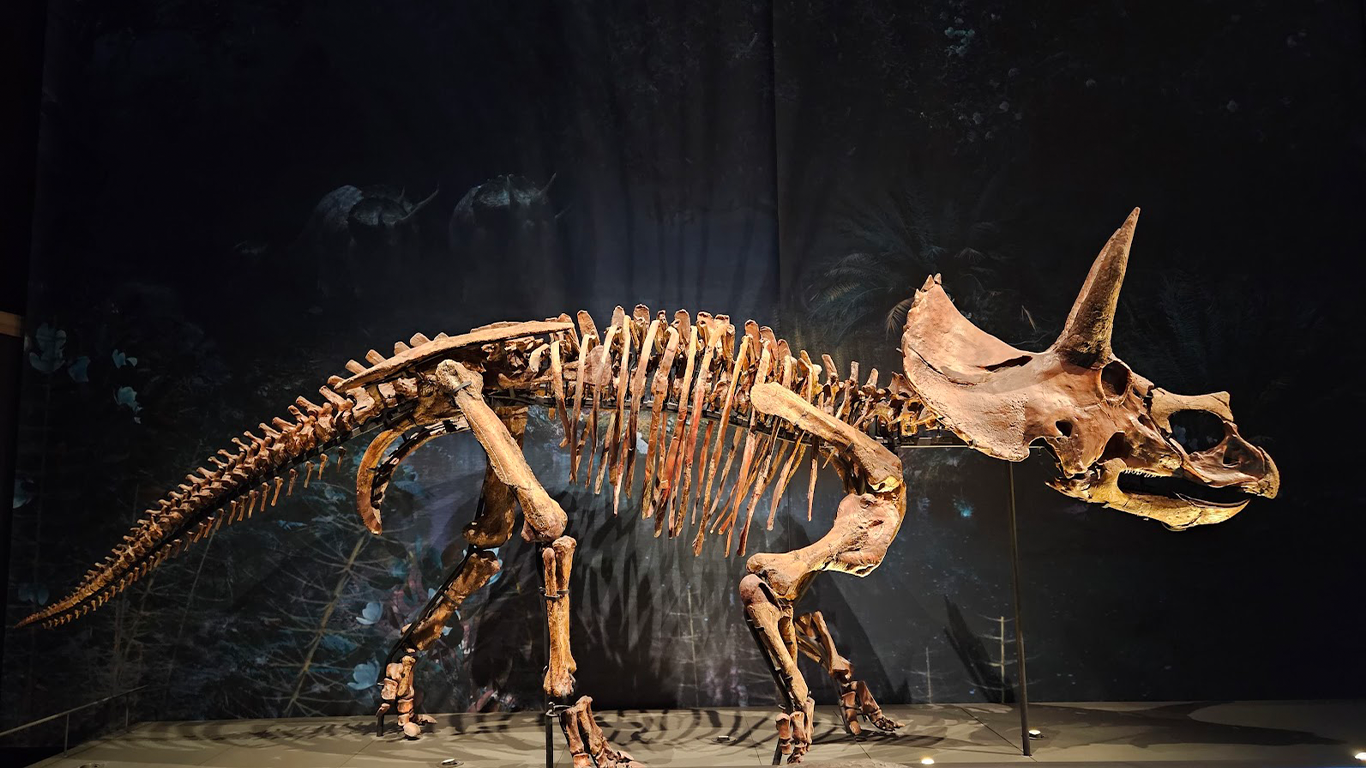On 17-18 September 2025, the Biodiversa+ Midterm Conference gathered participants from across Europe and beyond at the Naturalis Biodiversity Center in Leiden and online. The event marked an important milestone: a moment to reflect on what the Partnership has achieved since its launch in 2021, and to look ahead to the road towards 2028. Over two days, participants discussed achievements, challenges, and opportunities across the four Biodiversa+ flagship programmes and explored how to strengthen the bridge between science, policy, practice, and society.
The conference opened with a clear message: biodiversity action must be accelerated, and partnerships like Biodiversa+ have a central role to play. Speakers underlined that political attention often remains short-term, yet implementing the European Green Deal and the EU Biodiversity Strategy requires sustained commitment, coordination, and vision. The opening highlighted several key messages:
- Biodiversity needs a new narrative, one that conveys its urgency and relevance for everyone.
- Funding mechanisms must become more flexible, sustained, and efficient, optimising complementarity between EU and Member State investments.
- Partnerships must be bold and visible, shaping the agenda rather than adapting to it.
“Partnerships like Biodiversa+ must communicate boldly and clearly, not only with the EU but also with Member States. If funding instruments aren’t well designed, we lose time and energy, and science suffers. Efficient partnerships with sustained funding and flexible rules are essential to meet the scale of the challenge.”
— Philippe Tulkens (DG RTD)
Scaling up restoration requires coherent planning, shared stewardship, and openness about both successes and failures. (timestamp)
The session on the Protection & Restoration Flagship furthered the discussions by linking Biodiversa+’s work to the EU Nature Restoration Regulation and national restoration plans. Participants stressed that restoration must operate across multiple scales and integrate ecological, social, and economic dimensions.
Through calls such as BiodivProtect and BiodivConnect, and supporting activities like policy dialogues and desk studies, Biodiversa+ has been fostering R&I and helping Member States strengthen restoration planning and monitoring capacities.
The BiodivRestore Knowledge Hub was highlighted as a key tool for bringing together diverse expertise and connecting research with practice, offering guidance and sharing project insights.
Discussions also touched on data gaps, social acceptance, and the role of local communities in long-term stewardship of protected areas, with a case study from the TransNature project.
Participants called for a culture of learning that values transparency and shared experience:
- Policymakers need practical evidence: clear examples of what works, where, and under which conditions.
- Failures should be documented and shared to prevent repetition of mistakes and to improve efficiency.
- Governance innovations, including shared stewardship and collaborative management of protected areas, require stable frameworks and financing.
“We’re always asked for success stories, but it’s also the failures we need to learn from, so we don’t keep wasting time, money, and effort repeating the same mistakes. Since publishing failures isn’t rewarded in science, policymakers being more open to asking for them could help everyone move forward faster.”
— Richard Lilley (BiodivRestore Knowledge Hub)
European countries are aligning biodiversity-monitoring investments and methods to build a shared system and community of practice. (timestamp)
Monitoring is central to tracking biodiversity trends and to informing policy instruments such as the Nature Restoration Regulation. The Biodiversity Monitoring Flagship showcased how Biodiversa+ is helping countries map their monitoring activities, identify overlaps and gaps, and start building a coherent transnational monitoring network.
Speakers highlighted tangible progress:
- National coordination centres and thematic hubs are emerging as the backbone of a European monitoring infrastructure.
- By testing emerging technologies such as bioacoustics, eDNA, and remote sensing, Biodiversa+ pilots serve as “test beds” to identify real-world implementation challenges and strengthen harmonisation and capacity building.
- Collaboration with GBIF and the European Environment Agency (EEA) is enhancing data interoperability and standardisation.
Key challenges highlighted include
- Managing large volumes of data and ensuring quality. Effective use of AI and big data depends on standardisation and shared protocols.
- Supporting policymakers in translating complex global reports into actionable local policies. This requires stronger knowledge brokerage and better alignment between national, European, and global strategies.
- Ensuring alignment beyond technical methods. Governance and funding mechanisms also need coordination to maintain continuity beyond project cycles.
“For the first time, ministries across Europe are gaining a clearer picture of how much they invest in biodiversity monitoring. Biodiversa+ helped partners assess and align national spending, laying the foundation for better coordination. With initiatives like the European Biodiversity Monitoring Week launching in May 2026, we’re building a lasting community.”
— Petteri Vihervaara (Finnish Ministry of the Environment, Biodiversa+ Monitoring Work Package Leader)
The challenge is no longer identifying what must change, but learning how to make that change happen within complex social and economic systems. (timestamp)
During the session on the Societal Transformation Flagship, speakers noted that while biodiversity science has long defined the problems, driving real systemic change remains a challenge. The focus is now on identifying pathways, levers and enabling conditions that turn knowledge into action, including testing solutions, fostering new narratives and supporting those who implement change. Discussions built on mapping exercises and dialogues around rethinking quality of life, integrating diverse knowledge systems, and placing equity and justice at the heart of transformation.
Key messages from the discussion included:
- Despite being difficult to implement, inter- and transdisciplinary approaches are essential to navigate trade-offs and design viable transitions. Living labs and co-created experiments offer promising ways to test transformative approaches with businesses and communities
- A major barrier to transformative change is the disconnect between its theoretical urgency and the reality of short-term, project-based approaches.
- Communication must evolve, from focusing solely on species protection to highlighting risk and competitiveness. Nature should be framed as a core component of economic resilience, with nature-dependent sectors generating over half of global GDP.
“The biggest gap lies between our theoretical understanding of transformative change and our continued reliance on linear, project-based approaches in both research and policy. We often articulate that transformative change involves shifting power relations, changing mental models, and working across scales. Yet, we still design three-year projects with fixed outcomes and develop policies that address symptoms rather than the deeper structural issues.”
— Boipelo Tshwene-Mauchaza (UNEP-WCMC)
Nature-based Solutions (NbS) can reconcile ecological, social and economic goals, but only if they are rooted in biodiversity, justice, and long-term stewardship. (timestamp)
The NbS Flagship session explored both the potential and the challenges of mainstreaming NbS. Speakers emphasised the foundational role of BiodivERsA in advancing NbS, showcasing initiatives that connect research, innovation, and policy to make NbS operational. While the EU has demonstrated global leadership in NbS research, participants agreed that this must now translate into scalable and equitable implementation. Biodiversa+ was highlighted as a key bridge between science, policy, and practice. However, speakers also warned that the growing popularity of NbS carries risks, particularly when used as superficial “green labels” without proper safeguards, which can lead to greenwashing, land-rights conflicts, and social inequities.
Key priorities emerged from the discussions:
- Clear definitions, transparent reporting, and legal safeguards are essential to prevent greenwashing and protect land rights in Nature-Based Solutions (NBS).
- Inclusive governance, local participation, and collaboration across agriculture, business, and urban planning sectors are key to designing and sharing the benefits of NBS effectively.
- Implementing NBS successfully requires adaptive approaches, including “learning by doing” and involving non-traditional allies like engineers and technicians in design and monitoring.
“We need to stop waiting for perfect definitions and start learning by doing. In the Netherlands, strong collaboration between NGOs and other sectors has led to practical nature restoration within wind farms, real progress through action. And to make that happen, we need new allies. As an ecologist, I’ve found my most valuable partners are engineers. They challenge ideas, bring practical insight, and help turn ambition into reality.”
— Karin Bilo (Ørsted)
Turning knowledge into policy and practice requires long-term funding, knowledge brokers, and co-designed, targeted outputs for decision-makers and business. (timestamp)
Sessions on policy and business needs underscored the importance of converting scientific insights into actionable solutions. Valérie Drezet-Humez (EC DG ENV) called for ready-to-use monitoring tools and creative policy mechanisms that can be quickly adopted by Member States. From the business perspective, Martine van Weelen (Capitals Coalition) stressed that companies need practical frameworks, such as the ACT-D approach, to integrate biodiversity into their decisions.
Discussions highlighted persistent barriers and practical proposals:
- Short-term funding limits continuity; partners urged creation of a central biodiversity node to sustain data and knowledge beyond project cycles.
- Broader engagement, involving youth, cities, SMEs and civil-society organisations, can increase legitimacy and uptake.
- Knowledge brokers and intermediaries are needed to translate scientific outputs for policymakers, local authorities, and business actors.
“We still face major gaps, between research and application, and between policy ambition and implementation. To close these, we need reliable, affordable monitoring methods and stronger collaboration with stakeholders. But we also face a gap in narratives. Nature must be seen not just as a conservation issue, but as a driver of competitiveness.“
— Valérie Drezet-Humez (European Commission DG ENV)
Stronger collaboration among initiatives will amplify Europe’s impact and prevent duplication in the global biodiversity landscape. (timestamp)
The next session took a step back to reflect on Biodiversa+’s role within the wider network of European and global biodiversity initiatives. Europe’s biodiversity landscape is now dense with activity, an encouraging sign, but also a coordination challenge. Biodiversa+ was recognised as a “backbone” partnership capable of linking funders, researchers, policymakers and other initiatives across borders, ensuring complementarity rather than overlap.
Speakers called for continued efforts to:
- Strengthen coordination and complementarity among EU and global initiatives, building a “network of networks” that can inform both European and international biodiversity agendas and streamline the science–policy interface from local to global levels.
- Support the mobilisation and interoperability of open data and persistent identifiers, in collaboration with GBIF, the EEA, and other key actors. Panelists highlighted Biodiversa+’s role in filling assessment gaps and catalysing knowledge for international processes.
- Deepen engagement with cities and local actors, recognising their role in driving bottom-up change. This is especially important in the face of political volatility and fragmentation, which can hinder biodiversity prioritisation and visibility.
- Coordinate regularly with other EU initiatives to maintain visibility, avoid duplication, and communicate a coherent European narrative.
The conference marked the official launch of new key collaborations between Biodiversa+ and four major European initiatives: COOP4CBD, BioAgora, RESPIN, and the ECA Network. These collaborations aim to enhance coordination through shared events, data handovers, and joint capacity-building activities, helping to translate knowledge into action for a wide range of users.
“Biodiversa+ is a unique regional knowledge hub; we haven’t found anything comparable elsewhere. Biodiversa+ not only funds impactful projects that feed into our assessments, but also clusters and synthesises results, making it easier to use that knowledge globally. Their work on monitoring and engaging ministries and practitioners also strengthens the data we rely on, and that’s essential for advancing our understanding of biodiversity.“
— Isabel Sousa Pinto (IPBES)
The next phase of Biodiversa+ must focus on visibility, continuity, and collaboration beyond traditional partners.
The conference concluded with a co-creation exercise on Biodiversa+ beyond 2028. Participants reflected on the Partnership’s strengths (diversity, strong collaboration, monitoring capacity…) alongside ongoing challenges such as administrative complexity, heavy workloads, and the limited timeframe of funding streams. The European Commission reminded participants that upcoming negotiations for the next EU Framework Programme will be decisive for the Partnership’s future.
“We’ve been active for four years now, but our first projects are still ongoing, so we’re only just beginning to see the initial results from funded projects, pilots, and other activities. There’s much more to come. The challenge now is to make these results visible, sharing not only successes but also lessons learned, building strong narratives, and reaching beyond our usual circles.”
— Ron Winkler (Dutch Research Council, Co-Chair of Biodiversa+)
17–18 September 2025
Naturalis Biodiversity Center, Leiden (NL) & Online
Biodiversa+ has reached its midpoint!
Join us as we bring together partners and stakeholders to reflect on our progress and co-design the road ahead.
What to expect?
- Showcases of Biodiversa+ Flagships, partner testimonies, and project spotlights
- In-depth exchanges on the Partnership model and its added value
- Insights into key challenges and the evolving landscapes of research, policy, and practice
- Forward-looking discussions, from the next EU Framework Programme to long-term biodiversity strategies
…and much more.
The event will feature contributions from the European Commission as well as key stakeholders from the Biodiversa+ community and beyond.
On-site participation is limited, but full online access will be available to ensure everyone can take part.
